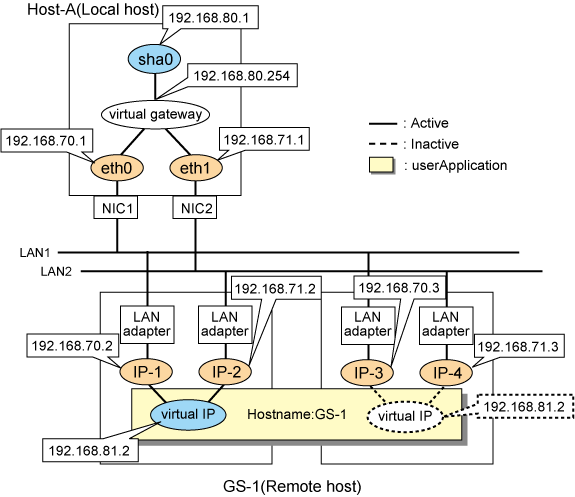This section describes an example configuration procedure of the network shown in the diagram below.
For the network configuration other than GLS, refer to "3.2.2 Network configuration".
For the GS configuration, refer to GS manual.
The dotted line indicates that the interface is inactive.

[HOST-A]
1) Setting up the system
1-1) Define IP addresses and hostnames in /etc/hosts file.
192.168.70.1 host11 # HOST-A Physical IP 192.168.71.1 host12 # HOST-A Physical IP 192.168.80.1 hosta # HOST-A Virtual IP 192.168.80.254 virgw # Virtual gateway 192.168.70.2 gs11 # GS-1 Physical IP(IP-1) 192.168.71.2 gs12 # GS-1 Physical IP(IP-2) 192.168.70.3 gs13 # GS-1 Physical IP(IP-3) 192.168.71.3 gs14 # GS-1 Physical IP(IP-4) 192.168.81.2 gsa # GS-1 Virtual IP |
1-2) Configure /etc/sysconfig/network-scripts/ifcfg-ethX (X is 0,1) file as follows.
Note
The following setting example (/etc/sysconfig/network-scripts/ifcfg-ethX) is for RHEL5. For details, see "3.2.2 Network configuration".
Contents of /etc/sysconfig/network-scripts/ifcfg-eth0
DEVICE=eth0 BOOTPROTO=static HWADDR=XX:XX:XX:XX:XX:XX HOTPLUG=no BROADCAST=192.168.70.255 IPADDR=192.168.70.1 NETMASK=255.255.255.0 NETWORK=192.168.70.0 ONBOOT=yes TYPE=Ethernet |
Contents of /etc/sysconfig/network-scripts/ifcfg-eth1
DEVICE=eth1 BOOTPROTO=static HWADDR=XX:XX:XX:XX:XX:XX HOTPLUG=no BROADCAST=192.168.71.255 IPADDR=192.168.71.1 NETMASK=255.255.255.0 NETWORK=192.168.71.0 ONBOOT=yes TYPE=Ethernet |
1-3) When the system is RHEL, on the /etc/sysconfig/network file, define a statement which enables the network configuration.
NETWORKING=yes |
1-4) Set the static route information of the virtual gateway for the remote host's virtual IP address in /etc/sysconfig/network-scripts/route-"interface name".
Contents of /etc/sysconfig/network-scripts/route-sha0
GATEWAY0=192.168.80.254 # Virtual gateway NETMASK0=255.255.255.255 # Subnet mask ADDRESS0=192.168.81.2 # GS-1 Virtual IP |
2) Reboot
Run the following command to reboot the system. After rebooting the system, verify eth0 and eth1 are active using ifconfig command.
/sbin/shutdown -r now
3) Setting a subnet mask
/opt/FJSVhanet/usr/sbin/hanetmask create -i 192.168.80.0 -m 255.255.255.0
4) Creating of virtual interface
/opt/FJSVhanet/usr/sbin/hanetconfig create -n sha0 -m c -i 192.168.80.1 -t eth0,eth1
5) Setting the Communication target monitoring function
/opt/FJSVhanet/usr/sbin/hanetobserv create -n GS-1 -i 192.168.81.2 -t 192.168.70.2,192.168.71.2 /opt/FJSVhanet/usr/sbin/hanetobserv create -n GS-1 -i 192.168.81.2 -t 192.168.70.3,192.168.71.3
6) Setting a virtual gateway
/opt/FJSVhanet/usr/sbin/hanetgw create -n sha0 -g 192.168.80.254
7) Activating of virtual interface
/opt/FJSVhanet/usr/sbin/strhanet
[GS-1]
Set the information for HOST-A's physical IP address and virtual IP address. For information on how to do this, see the GS manual.